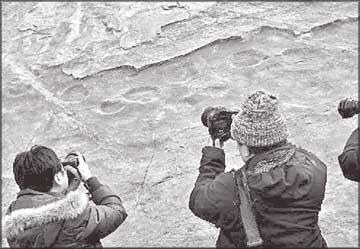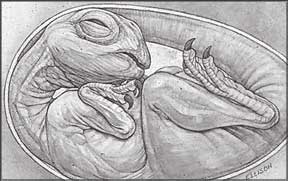Dinosaur footprints discovered in Beijing
Paleontologists say several hundred fossilized footprints in a
Beijing suburb are those of dinosaurs. The footprints, unearthed in a
geological park in Yanqing county, are the first dinosaur traces the
city has found, according to Zhang Jianping, researcher at the China
University of Geosciences.
They were left by dinosaurs that lived some 140 to 150 million years
ago in the late Jurassic period, said Zhang.
|

Photographers shoot fossilized footprints at a geological
park in Yanqing County, Beijing on January 9, 2012.
Paleontologists said that several hundred fossilized
footprints unearthed in the suburb park were those of
dinosaurs. The footprints were left by dinosaurs that lived
some 140 to 150 million years ago in the late Jurassic
period, said Zhang Jianping, researcher at the China
University of Geosciences. They are the first dinosaur
traces the city has found, according to Zhang.
Xinhua/Zhang Yu |
A group of scientists from Zhang’s university first discovered the
footprints in July 2011 in the Guihuamu Geological Park, which is known
for its concentration of petrified ancient woods.
In one spot where most of the footprints are concentrated, the
paleontologists counted several hundred footprints as well as seven to
eight lines formed by consecutive steps.
Thyreophoras, theropods, ornithopods, and probably sauropods are
believed to have left the footprints. The discovery will benefit the
study of China’s dinosaur categories at late Jurassic and early
Cretaceous periods, Zhang said.
“It’s the first time China has found thyreophora, ornithopod, and
sauropod footprints of that period, which provides us with more
knowledge on how such species spread across China,” said Zhang.
Meanwhile,New findings suggest that a prehistoric asteroid collision
is not solely responsible for wiping out the dinosaur population in
northeast Asia 65 million years ago.
Scientists now claim that the end of the long-gone reptile’s reign in
some regions of northeast Asia can be linked to several other factors,
including volcanic eruption, climate change and drops in sea level.
A new China-led study by 30 scientists from eight different countries
has yielded powerful evidence challenging the dominant, decades-old
scientific theory that dinosaurs were wiped out after an asteroid
collided with the earth.
|

Fossilized dinosaur remains Xinhua/Zhang Yu |
The study was made public during an ongoing seminar of geology and
paleontology in Jiayin, a county in northeastern Heilongjiang Province,
where scientists have found fossils of dinosaurs living just before the
species’ sudden demise.
The scientists, including experts from Russia, the U.S., Germany,
Belgium, Britain, Japan and the Republic of Korea, were led by Sun Ge of
Jilin University in northeast China. Together, they have spent the past
ten years studying the extinction of dinosaurs.
The study showed that in Jiayin the K-T boundary, the geologic
boundary between the rocks of the Cretaceous and Tertiary periods, does
not contain high-levels of iridium, a radioactive element that linked an
asteroid strike to the extinction of dinosaurs.
The asteroid theory has dominated dinosaur studies for several
decades after scientists found high-levels of iridium in the K-T
boundaries in North America and other regions. The element is rare on
Earth, but found in extraterrestrial objects, including asteroids,
according to Sun Ge.
Among conflicting and controversial hypotheses explaining dinosaur
extinction, the asteroid theory is the only one that has been proven by
scientific evidence and is universally recognized by scientists, Sun
said.
Scientists believe a giant asteroid that hit the earth about 65
million years ago sealed the fate of dinosaurs forever by throwing up
gusts of dust or chemical clouds that blocked sunlight from reaching the
planet, or by igniting global wildfires.
However, the new study suggests that volcanic activities around that
time greatly impacted the environment of the Jiayin area and could be to
blame for the species’ extinction.
Geologic features of and around the K-T boundary in Jiayin are
identical to those of and around the same layer in Russian regions of
Siberia and the Far East, said Sun Ge.
Regions in northeast Asia had similar geographic environments 65
million years ago, where volcanic eruption, climate cooling and up to
100-meter drops in sea-level might have been the major factors that
wiped out the dinosaurs, said Akhmetiev M, a Russian geologist who
participated in the program.
According to Sun, the world’s 105 sections of K-T boundary suggest a
mega-wipeout 65 million years ago that destroyed over 70 percent of all
the earth’s species, including the dinosaurs.
The extinction of dinosaurs was caused by different factors in
different regions, and an asteroid is not the only reason, Sun said.
Meanwhile,Dinosaur footprints near the proposed multi-billion dollar
Kimberley gas hub in Western Australia (WA) will be examined by Canadian
and U.S. paleontologists, local media reported on Thursday.
The dinosaur footprints are embedded in rock close to where the state
and federal governments want to build a 35 billion AU dollars (35.85
billion U.S. dollars) liquefied natural gas (LNG) precinct north of
Broome, according to the Australian Broadcasting Corporation (ABC).
The two specialists are Dr. Martin Lockley, professor of geology at
the University of Colorado in Denver, and Richard McCrea, curator of the
Peace Region Paleontology Research Center in Canada.
Within two weeks, they will conduct fresh studies of the site to
establish how important the prints are after a previous study found they
were not of “museum quality”.
WA Department of State Development Deputy Director Nicky Cusworth
says she does not expect any discoveries that could derail the
development.
“We hope the new survey improves our understanding of the dinosaur
footprint issues and the best approach to managing, and minimizing the
impact of the precinct on valuable fossil records,” she said.
Australian Queensland paleontologist Steve Salisbury, who has carried
out recent research at the James Price Point site, believes the new
study will show the dinosaur prints and the gas hub can not co-exist.
“I am pretty sure that if they’ve seen what we’ve seen up in that
area then the Department of State Development and the state government
are in for a bit of a surprise,” he told ABC Radio.
Meanwhile,Chinese and Japanese scientists have announced the
discovery of a new dinosaur species in the eastern province of Zhejiang,
13 years after the prehistoric creature’s skeleton was unearthed during
highway construction.
The dinosaur is a new species of Ornithischians, also known as
“bird-hipped” dinosaurs because of their bird-like hip structure. They
lived in the Cretaceous period about 100 million years ago.
Scientists made their conclusion after more than three years of
intensive study of a partial but well-preserved skeleton, said Zheng
Wenjie, a geoscientist with the Zhejiang Museum of Natural History,
where the skeleton has been preserved since it was discovered during
construction of a highway in 1998 in Tiantai county, eastern Zhejiang
province.
They named the new species “Yueosaurus Tiantaiensis”, or “Tiantai Yue
Dinosaur” in Chinese, as it was discovered in the present-day Tiantai
county and the region used to be the territory of the ancient State of
Yue during the Spring and Autumn Period over 2,500 years ago, according
to Zheng.
The new species represents the southernmost basal ornithopod dinosaur
from Asia, also the first one from southeastern China, according to the
paper written by Zheng and his four co-researchers, two from China and
two from Japan.
The paper was published this month by British magazine Cretaceous
Research and the two Japanese scientists, Masateru Shibata and Yoichi
Azuma, are from the Fukui Prefectural Dinosaur Museum.
Ornithopods are a group of ornithischian dinosaurs that started out
as small, bipedal running grazers, and grew in size and numbers until
they became one of the most successful groups of herbivores in the
Cretaceous world.
Though the species dominated the North American landscape, they were
rare in Asia.
Before Yueosaurus, only four Ornithopod species had been found in
Asia - in northeastern China’s Liaoning and Jilin provinces, the
Republic of Korea and Mongolia.
The beaked, herbivorous creature, only 1.5 meters long and one meter
tall, is the smallest dinosaur ever found in the province, according to
Zheng.
“They were great runners. They are really small, so they had to run
away fast from those ferocious meat-eating dinosaurs,” Zheng said.
Latest research has showed that some of them even burrowed and lived
in holes in the ground, he added.
Zhejiang boasts vast areas of land rich in dinosaur and dinosaur egg
fossils. Four new dinosaur species, three herbivorous and one
carnivorous, had been discovered in the province before Yueosaurus,
according the museum, which is located in Hangzhou, capital of Zhejiang.
Xinhua |



